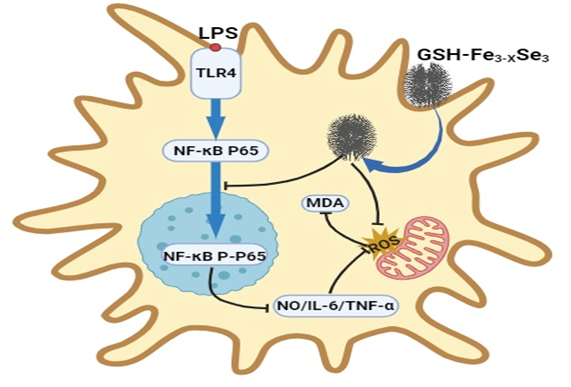This study focuses on the treatment of cisplatin-induced acute kidney injury (AKI). Extensive research has demonstrated that oxidative stress and inflammatory responses caused by excessive production of reactive oxygen species (ROS) play a critical role in the progression of AKI. Therefore, exploring effective and safe antioxidants and anti-inflammatory agents to scavenge overexpressed ROS and regulate excessive inflammation has become a promising therapeutic strategy. Glutathione and iron selenide both possess anti-inflammatory and antioxidant properties. Based on this, we successfully developed glutathione-modified iron selenide nanoparticles (GSH-Fe3-XSe3 NPs) with a particle size of approximately 200 nm, which exhibit excellent biosafety. This study comprehensively investigated the antioxidant and anti-inflammatory capabilities of GSH-Fe3-XSe3 NPs. Firstly, the anti-inflammatory and antioxidant properties of GSH-Fe3-XSe3 NPs were assessed at the cellular level. Additionally, the effects of GSH-Fe3-XSe3 NPs on ROS and MDA levels and the expression of inflammation-related cytokines (TNF-α, IL-6) in lipopolysaccharide (LPS)-induced inflammatory cells were investigated. The antagonistic effect of GSH-Fe3-XSe3 NPs on LPS-induced inflammation in RAW264.7 cells was confirmed. Secondly, the anti-inflammatory mechanism of GSH-Fe3-XSe3 NPs was explored using WB. Finally,in this study, an AKI mouse model was established by intraperitoneal injection of cisplatin. The safe dosage of GSH-Fe3-XSe3 NPs in healthy mice was determined, and the biosafety of GSH-Fe3-XSe3 NPs was analyzed. The therapeutic effect of GSH-Fe3-XSe3 NPs on mice with acute kidney injury was evaluated by measuring serum levels of AKI-related inflammatory factors. Experimental results demonstrated that GSH-Fe3-XSe3 NPs can simultaneously scavenge ROS, malondialdehyde (MDA), and nitric oxide (NO), showing excellent cytoprotective effects against oxidative stress-mediated damage. Furthermore, in a cisplatin-induced AKI mouse model, GSH-Fe3-XSe3 NPs significantly reduced the expression levels of blood urea nitrogen (BUN), serum creatinine (SCR), MDA, tumor necrosis factor-α (TNF-α), and interleukin-6 (IL-6) under AKI conditions, markedly improving the symptoms of AKI mice. In conclusion, the GSH-Fe3-XSe3 NPs prepared in this study, through their dual mechanisms of antioxidant and anti-inflammatory actions, achieved therapy for cisplatin-induced AKI, providing a novel therapeutic approach for AKI treatment.

A Yuanfang He
,
Fang Liu
,
Lan Wei
,
Yongfang Wang
,
Jiangfeng Du
. Application of glutathione-modified iron selenide nanoparticles in the repair of acute kidney injury[J]. Acta Chimica Sinica, 0
: 25040139
-25040139
.
DOI: 10.6023/A25040139
[1] Dos Santos. N. A. G.; Carvalho Rodrigues M. A.; Martins, N. M. Arch. Toxicol.2012, 86, 1233-1250.
[2] Chen X.; Wei W.; Li, Y. Chem. Biol. Interact.2019, 308, 269-278.
[3] Hoste E. A.; Bagshaw S. M.; Bellomo R.Intensive Care Med.2015, 41, 1411-1423.
[4] Jentzer J. C.; Bihorac A.; Brusca, S. B. J. Am. Coll. Cardiol.2020, 76, 1084-1101.
[5] Chen Y.; Li Z.; Zhang, H. Signal Transduct. Target. Ther.2024, 10, 69.
[6] Sheng F.; Li M.; Yu J.M. Front. Immunol.2025, 16, 1533335.
[7] Pavlakou P.; Liakopoulos V.; Eleftheriadis, T. Oxid. Med. Cell. Longev.2017, 2017, 6193694.
[8] Santos N.; Catão C.; Martins N. Arch. Toxicol.2007, 81, 495-504.
[9] Aksu U.; Demirci C.; Ince C. Contrib. Nephrol.2011, 174, 119-128.
[10] Li Z.; Chen J.; Tian H. Y.; Chen X. S.Acta. Chim Sinica 2022, 80, 668-678 (in chinese). (李真, 陈杰, 田华雨, 陈学思, 化学学报, 2022, 80: 668-678.)
[11] Ma N.; Wei W.; Fan X. Front. Pharmacol.2019, 10, 1419.
[12] Liu Z.; Qu M.; Yu L. Inflammation.2018, 41, 1546-1556.
[13] Han S. J.; Lee, H. T. Kidney Res. Clin. Pract.2019, 38, 427-440.
[14] Lan T.Y.; Dun R.L.; Yao D.S. Front. Pharmacol.2023, 9, 1064507.
[15] Wang Y.; Jiang H.; Zhang, L. Front. Bioeng. Biotechnol.2023, 11, 1120148.
[16] Dennis J. M.; Witting P. K. Nutrients.2017, 9, 718.
[17] Zhang X. L.; Tian G.; Zhang X.; Wang Q.; Gu, Z. J. Acta Chim. Sinica2019, 77, 406-417 (in chinese). (张晓蕾, 田甘, 张潇, 王清, 谷战军,化学学报, 2019, 77, 406-417.)
[18] Chen Q W; Zjang X Z. Acta Chim. Sinica2023, 81, 1043-1051 (in chinese). (陈其文, 张先正, 化学学报, 2023, 81, 1043-1051.)
[19] Qin Y.J.; Han Y.; Jin H.; Gao Y.;Shan, X. Q. Chin Sci Bull2020, 65, 203-212 (in chinese). (秦玉杰, 韩宇, 靳杭, 高颖, 单晓茜, 科学通报, 2020, 65, 203-212.)
[20] Nemmar A.; Al-Salam S.; Al Ansari, Z. Cell. Physiol. Biochem.2019, 52, 439-454.
[21] Jiang D.; Ge Z.; Im, H. J. Nat. Biomed. Eng.2018, 2, 865-877.
[22] Zhou J.; Guan M.; Ma, H. Mater. Today. Bio.2024, 62, 102775.
[23] Xue X. K.; Li J.; Liang H.Y.; Wang Y.Y.; Ge J.C.Chem. J.Chin. Univ.2025, 46, 20250094 (in chinese). (薛小矿, 李建, 梁焕仪, 王一颖, 葛介超, 高等学校化学学报, 2025, 46, 20250094.)
[24] Zhang J.; Ren X.; Nie Z. J. Nanobiotechnolog.2024, 22, 626.
[25] Wang S.; Chen Y.; Han, S. Int. J. Nanomed.2022, 12, 3882-3895.
[26] Alrashedi B. M.; Mohamed R. A.; Mohamed A. H. Biometals.2023, 43.
[27] Davoudi M.; Jadidi Y.; Moayedi K. J. Nanobiotechnology.2022, 20 , 504.
[28] Li S., Dai Q., Zhang, S. Acta Pharmacologica Sinica.2018, 39, 1294-1304.


